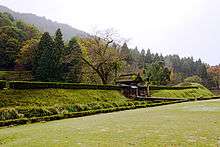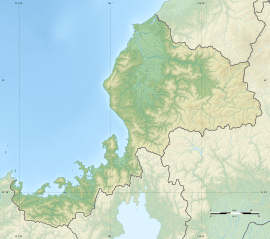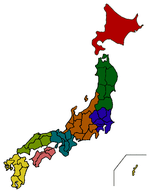Ichijōdani Asakura Family Historic Ruins
The Ichijōdani Asakura Family Historic Ruins (一乗谷朝倉氏遺跡, Ichijōdani Asakura-shi Iseki) are historic ruins located in the Kidonouchi section of the city of Fukui, Fukui Prefecture, in the Hokuriku region of Japan. This area was controlled by the Asakura clan for 103 years during the Sengoku period. It is designated as Special Historic Site in 1971, and in June 2007 2,343 artifacts were designated as Important Cultural Property.
一乗谷朝倉氏遺跡 | |
 Asakura Yakata ruins (Asakura Yoshikage`s residence) | |
 Ichijōdani Asakura Family Historic Ruins  Ichijōdani Asakura Family Historic Ruins (Japan) | |
| Location | Fukui, Fukui, Japan |
|---|---|
| Region | Hokuriku region |
| Coordinates | 35.999474°N 136.29557°E |
| History | |
| Founded | 1471 |
| Abandoned | 1573 |
| Periods | Muromachi period |
| Site notes | |
| Excavation dates | 1967-2020 |
| Ownership | Special National Historic Site |
| Public access | Yes |
Site
Ichijōdani is a valley of a branch of the Asuwa River with an east-west width of approximately 500 meters and a length of approximately three kilometers. The valley is surrounded by mountains on the east, west and south, and by the river to the north, forming a natural fortification.
History
In 1471, Asakura had displaced the Shiba clan as the shugo military commander of Echizen Province[1]. The same year, Asakura Toshikage (1428–1481) fortified the Ichijōdani by constructing hilltop fortifications on the surrounding mountains and constructing walls and gates to seal off the northern and southern end of the valley. Within this area, he contracted a fortified mansion, surrounded by the homes of his relatives and retainers, and eventually by the residences of merchants and artisans, and Buddhist temples. He offered refuge to people of culture or skills from Kyoto attempting to escape the conflict of the Ōnin War, and the Ichijōdani became a major cultural, military, and population center, and by the time of Asakura Takakage (1493–1548) it had a peak population of over 10,000 inhabitants. Yoshikage succeeded his father as head of the Asakura clan and castle lord of Ichijōdani Castle in 1548.[2][3] The Asakura maintained good relations with the Ashikaga shogunate, and thus eventually came into conflict with Oda Nobunaga. Following Nobunaga's capture of Kyoto, Shōgun Ashikaga Yoshiaki appointed Asakura Yoshikage as regent and requested aid in driving Nobunaga out of the capital.[4] As a result, Nobunaga launched an invasion of Echizen Province. Due to Yoshikage's lack of military skill, Nobunaga's forces were successful at the Siege of Kanegasaki and subsequent Battle of Anegawa in 1570, leaving the entire Asakura Domain open to invasion.[1][5][6]
Ichijōdani was razed to the ground by Nobunaga during the 1573 Siege of Ichijōdani Castle.[7]
Excavation of the ruins began in 1967[7][8] and continued on in 2017, revealing the shape of the whole town, including the house of the lord, samurai residences, temples, houses of merchants, houses of craft workers, and streets. Residences of samurai as well as merchants' quarters have since been restored along the 200 meter long street.[9] Four Japanese gardens were unearthed and partially restored, and those were designated as Places of Scenic Beauty in 1991. The ruins of Ichijōdani Castle (一乗谷城) are on top of a nearby hill, with a scenic view of Fukui.
Approximately 1,700,000 relics were found at the ruins, and of these 2,343 are nationally designated as Important Cultural Properties, many of which are on display at the Ichijodani Asakura Family Site Museum.[10]
Cultural properties
Designated in the following categories:
- Special Places of Scenic Beauty — The Gardens, including Nanyōji-ato Garden of a temple and those of residences (Suwa Yakata-ato, Asakura Yakata-ato, and Yudono-ato)
- Special Historic Sites — The whole site (278 hectares)
- Important Cultural Properties — 2,343 pieces from among excavated artifacts
 Suwa Yakata-ato Garden
Suwa Yakata-ato Garden Yudono-ato Garden
Yudono-ato Garden Asakura Yakata-ato Garden
Asakura Yakata-ato Garden Nanyōji-ato Garden
Nanyōji-ato Garden Stone wall of Nakanogoten gate
Stone wall of Nakanogoten gate
See also
References
- "Asakura Yoshikage". Encyclopedia of Japan. Tokyo: Shogakukan. 2012. OCLC 56431036. Archived from the original on 2007-08-25. Retrieved 2012-08-22.
- "朝倉 義景" [Asakura Yoshikage]. Nihon Jinmei Daijiten (日本人名大辞典) (in Japanese). Tokyo: Shogakukan. 2012. Archived from the original on 2007-08-25. Retrieved 2012-08-22.
- "朝倉 義景" [Asakura Yoshikage]. Nihon Kokugo Daijiten (in Japanese). Tokyo: Shogakukan. 2012. OCLC 56431036. Archived from the original on 2007-08-25. Retrieved 2012-08-22.
- "朝倉 義景" [Asakura Yoshikage]. Kokushi Daijiten (in Japanese). Tokyo: Shogakukan. 2012. OCLC 683276033. Archived from the original on 2007-08-25. Retrieved 2012-08-22.
- "朝倉義景" [Asakura Yoshikage]. Dijitaru Daijisen (in Japanese). Tokyo: Shogakukan. 2012. OCLC 56431036. Archived from the original on 2007-08-25. Retrieved 2012-08-22.
- Turnbull, Stephen (1987). Battles of the Samurai. Arms and Armour Press. p. 60. ISBN 978-0853688266.
- "Ichijodani Asakura Family Site Museum". Retrieved 2017-10-10.
- "Ichijōdani Asakura-shi iseki—hakkutsu chōsa seibi jigyō gaihō" [Ichijōdani Asakura Family Historic Ruins—General Report, Excavation and Research Project]. Fukui-ken Asuwa-chō. 1969. OCLC 77076512. Retrieved 2017-10-10. Cite journal requires
|journal=(help) - "Restored street of Ichijōdani (diolama)". Archived from the original on 2013-09-03. Retrieved 2017-10-10.
- "Shutsudohin gyararī" [Gallery of excavated artifacts] (in Japanese). Retrieved 2017-10-10.
External links
| Wikimedia Commons has media related to Ichijodani Asakura Family Historic Ruins. |
- Ichijōdani Asakura Family Site Museum website (in English)
- Ichijōdani Asakura Family Site Museum website (in Japanese)
